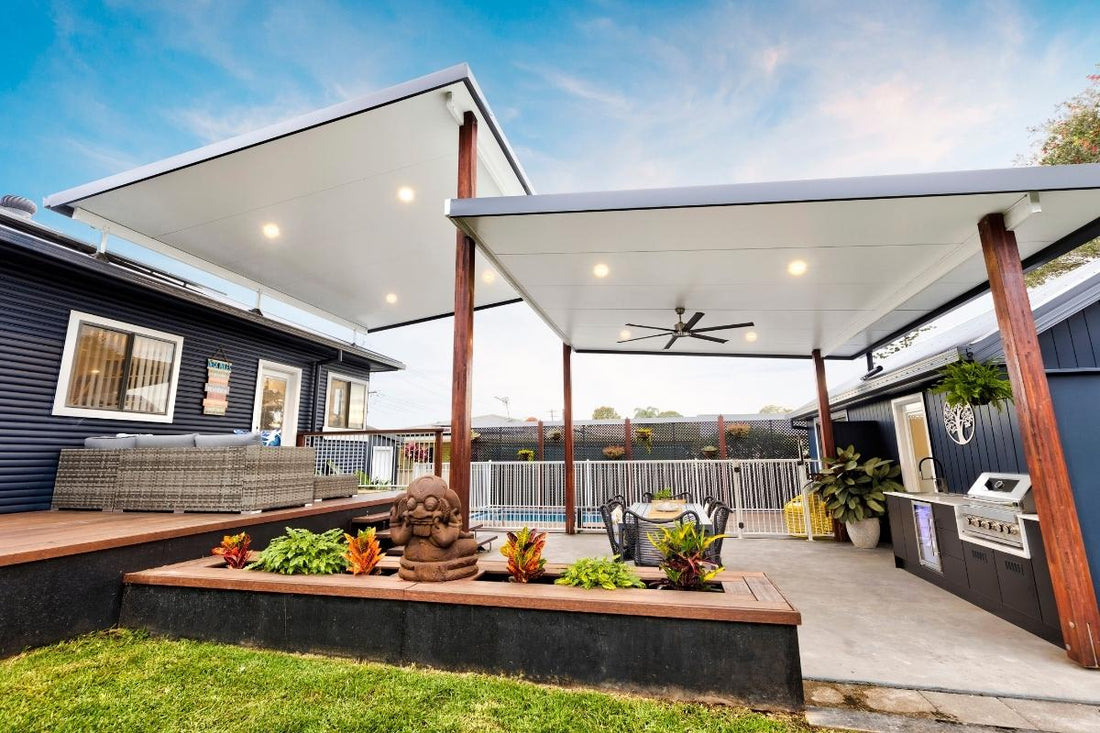Putting in insulated patio roofing panels? Here are some things to think about before beginning your project.
Insulating your patio roof is a crucial step in maintaining a comfortable and energy-efficient patio. Improved thermal insulation, lower energy use, and improved soundproofing are just a few advantages of insulated patio roof panels. Understanding how to install insulated patio roof panels is crucial whether you are considering a renovation or planning a new construction project. Insulated roof panels offer a number of benefits, such as better insulation, temperature control, and lower heating and cooling costs (plus they look sensational). Before you begin the installation process, there are a number of things to consider in order to guarantee a successful project. In order to help you make informed decisions and achieve the best results, we will walk you through the fundamental steps of installing insulated patio roof panels in this article.
Advantages of roof panel insulationThe excellent insulation offered by insulated roof panels offers a number of advantages for both residential and commercial structures.
An important benefit is increased energy efficiency. The need for excessive heating or cooling is decreased thanks to these panels' ability to minimize heat transfer through the roof. Insulated roof panels help to significantly reduce energy use and power costs by maintaining a moderated temperature.
Insulated roof panels can also result in lower heating and cooling expenses. Your heating and cooling systems can run more effectively and use less power to maintain the desired temperature with better insulation. This can eventually lead to significant cost savings and a greener footprint.
There are a number of crucial factors to take into account before you start installing insulated roof panels. Considering these factors will guarantee an effective installation that gives you long-term advantages.
- Building codes and regulations: It is important to become familiar with the building codes and regulations in your area (contact your local council for guidelines). Specific installation and insulation standards for roofs may vary by region. To avoid any future legal problems or complications, make sure you abide by all applicable local laws.
- Structural factors: Examine your patio roof's structural strength to see if the weight of the insulated roof panels can be supported by it. If you need to, speak with a structural engineer, especially if your roof is weakened or older. It is crucial to make sure the roof can support the extra weight safely without losing integrity. All of our new Smartkits designs incorporating these types of panels are all engineered and signed off.
- Climate and weather considerations: Be aware of the local climate and weather. The thermal resistance of various insulated roof panel types varies, which has an impact on how well they perform in various climates. Take into account the typical temperatures, the relative humidity, and the intensity of weather phenomena like storms or hail. To maximize their efficiency, pick insulated roof panels that are appropriate for your region's climate.
- The slope and design of your roof may have an impact on the installation procedure and the insulated roof panel you choose. Steeper roofs might need extra safety measures and specialised installation methods. Considerations for specific waterproofing may be necessary for flat roofs. The best method for installing the panels and ensuring proper drainage will depend on the slope and design of your roof.
- Fire safety: Insulated roof panels should follow fire safety regulations to protect your property and its occupants. Check the fire ratings and certifications of the panels you choose to ensure they meet the necessary safety requirements. Consider adding fire safety precautions like installing fire breaks between panels or applying fire-resistant coatings.
After taking these things into account and making the necessary preparations, you can start the installation procedure. It is crucial to adhere to the recommendations and instructions provided by the manufacturer for your particular brand of insulated roof panels. An overview of the installation procedure is provided below:

If you plan to work at heights, make sure you have the right safety gear, such as harnesses, gloves, and safety goggles. Before installation, make sure the roof is clean, dry, and free of any debris.
- Measure and evaluate the roof to look for any structural flaws or damage. To determine the number of insulated roof panels needed, take precise measurements of the roof area. Your design specialists here at Smartkits can help here.
- Choose the right insulated roof panels for your needs by taking into account characteristics like thermal resistance, fire rating, and durability. Once again we can guide you on these choices.
- Installing panels involves working your way across the roof from one corner. Utilizing the proper fasteners, fasten the panels in accordance with the manufacturer's instructions. To maintain the effectiveness of the insulation, make sure the panels are aligned properly and sealed tightly.
- Sealing and finishing touches: To stop air leakage and water infiltration, seal all joints, edges, and penetrations. To ensure a watertight installation, pay attention to details like flashings. Regular maintenance is necessary to guarantee the longevity and effectiveness of the insulated roof panels after they have been installed. Periodically clean the panels, check for damage, and take care of repairs right away.
Regular maintenance is crucial to extending the lifespan and effectiveness of your insulated roof panels. Here are some maintenance tips to consider:
- Clean the panels on a regular basis to get rid of dirt, debris, and any buildup that might be detrimental to their performance. Look for any damage, such as cracks or loose panels, and fix it right away.
- Schedule any necessary repairs or replacements as soon as you notice any damages or telltale signs of wear and tear.
- To maintain the effectiveness of your insulated roof panels, it is critical to take immediate action if you notice any damages or signs of wear and tear. Here are some maintenance tips to consider:
- Frequently clean the panels to get rid of any buildup, dirt, or debris that might impair their performance. Check the panels for cracks or loose pieces of material, and take immediate action to fix them.
- Arrange repairs or replacements as needed if you notice any damages or telltale signs of wear and tear. Make contact with a qualified roofing contractor who can evaluate the damage and suggest the best course of action.
- Various factors, including the caliber of the materials used, the method of installation, and maintenance, can affect how long insulated roof panels last. Insulated roof panels can typically last for 20 to 30 years, or even longer, with proper maintenance.
- You can make sure that your insulated patio roof panels last a long time and perform at their best by adhering to these maintenance procedures and taking care of any problems as soon as they arise.
Before installing insulated roof panels, it’s important to consider the associated costs. Here are some cost factors to keep in mind:
- Insulated roof panel prices can change depending on the brand, quality, and type. Choose a product that offers a good balance of quality and affordability by comparing prices from various suppliers. At Smartkits we only use the best quality panels on the market.
- The cost of installation will vary depending on the size and complexity of your roof, labor costs, and any additional requirements for safety precautions or specialized equipment. To get an accurate idea of the installation costs, request quotes from dependable builders.
- Insulated roof panels may be more expensive initially, but they can save money over time by improving energy efficiency and lowering heating and cooling costs. When assessing the overall return on investment, take into account the potential savings over the panels' lifespan.
It is advisable to speak with roofing professionals and builders and get multiple quotes in order to fully comprehend the costs involved with installing insulated roof panels. This will help you make informed decisions based on your financial situation and potential benefits.
The cost-effectiveness, energy efficiency, and temperature control of your building can all be significantly improved by using insulated roof panels. Building codes, structural considerations, environmental factors, roof slope and design, and fire safety are a few examples of factors that can help ensure a successful installation.
Through regular upkeep and prompt repairs, the lifespan and performance of insulated roof panels must be maximized. When making a decision, take into account all associated costs, including those for materials, installation, and any potential returns on investment.
You can reap the rewards of insulated patio roof panels for many years to come by making wise decisions and adhering to proper installation and maintenance procedures, making your home more comfortable and energy-efficient. To view our extensive range visit smartkits.com.au

